LisbonLisboaPortugal.com
The best independent guide to Lisbon
LisbonLisboaPortugal.com
The best independent guide to Lisbon
Mosteiro dos Jeronimos, Lisbon; an independent tourism guide for 2025
The splendid Mosteiro dos Jeronimos stands proudly as one of Lisbon's most important religious buildings, exemplifying the opulence and might of 16th-century Portugal.
This site was historically associated with Portugal's pioneering seafarers and explorers. Here, Vasco da Gama and Pedro Álvares Cabral held vigils, before their epic oceanic voyages to India and around Africa.
Later, the incredible riches amassed from the spice trade and gold funded the construction of the mighty Mosteiro dos Jeronimos. This transformed it from a simple chapel and hermitage (the Hermitage of Restelo) into one of Portugal's most impressive religious sites.
The construction spanned over a century, coinciding with the zenith of Manueline-style architecture (Portuguese late Gothic). Throughout the church and cloister, you will discover intricate stone carvings and flamboyant architectural details, along with the tombs of Portuguese kings and famous explorers.
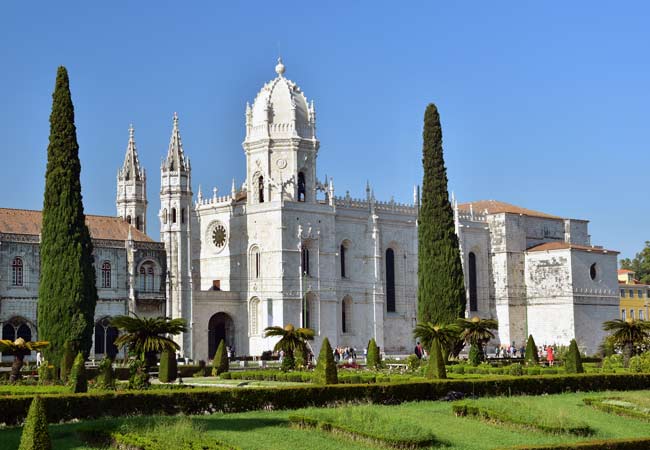
The Mosteiro dos Jeronimos is a vast complex comprising of three sections: the Igreja de Santa María church, the cloisters and the west wing - the latter of which houses Museu de Marinha and Museu Nacional de Arqueologia.
The Santa María church is free to visit, while the cloisters have paid admission, however, during peak times, these are rarely visited together, as they each have their own separate queues. There is no direct access (or queue jump) from the paid cloister section into the church, so you will need to queue twice if you want to see both. Also, to control visitor numbers, admission to the cloisters is via a timed ticket, which should be pre-booked in the summer months (link later in the article).
The actual paid cloister area is not that large, only including the upper and lower levels, the refectory and the Chapter House. The time spent inside, typically 45 minutes, can be as long as the wait to get in.
This article will provide an independent tourist guide to the Mosteiro dos Jeronimos and includes an image tour, to help you decide if it is worth your time and money to enter the cloisters.
Related articles: The Belem district – The Torre de Belém
Highlights of the Mosteiro dos Jeronimos
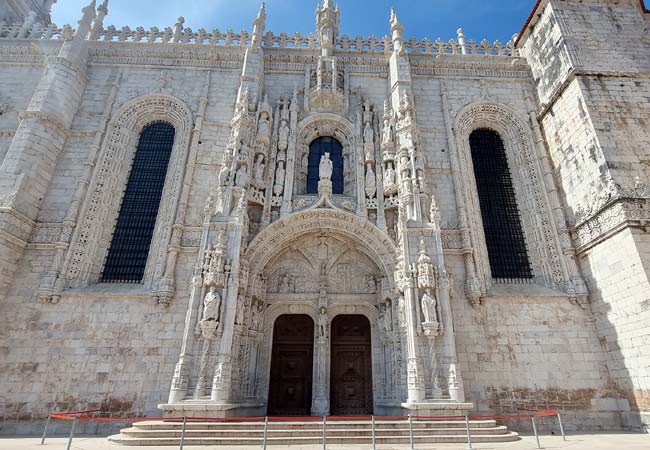
The Portal sul (Southern Portal) – The remarkable side entrance to the Santa María church, featuring beautifully carved figures and a centrepiece statue of Henry the Navigator, all sheltered beneath an array of pinnacles. Above the doors are scenes from Saint Jerome's life, as well as decorative Manueline elements, creating an unmissable spectacle of historical and architectural brilliance.
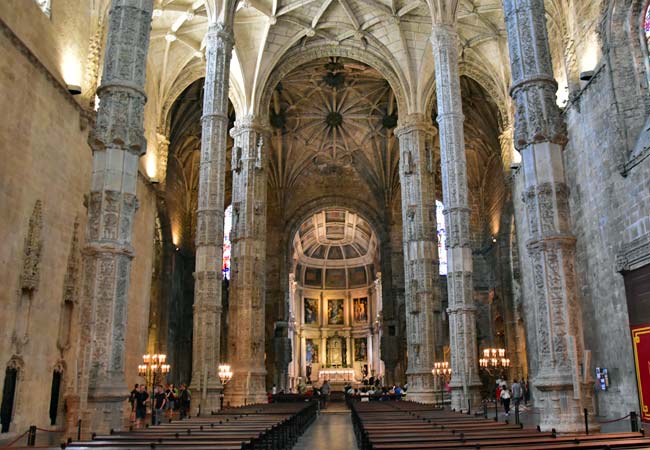
Igreja de Santa María de Belem – The impressive architecture of Santa María Church, with its single vaulted roof supported by spindly columns that withstood the 1755 earthquake. Within the church are exquisite 16th and 17th-century altars with Manueline-style carvings, along with the royal tombs of King Manuel I, King João III and Vasco da Gama.
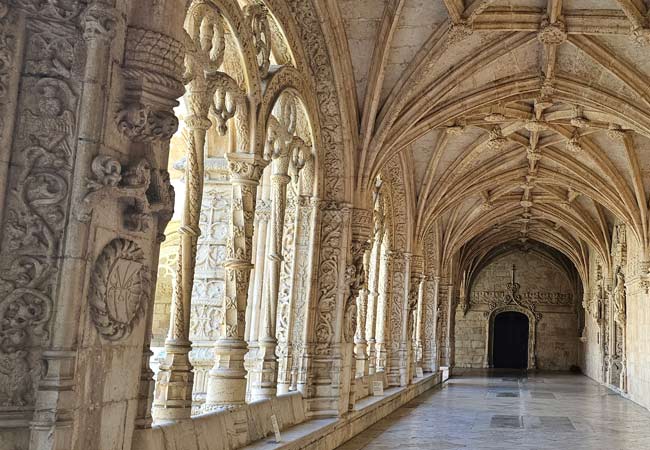
The cloisters - The finest example of Manueline architecture, with its wonderfully ornate stone carvings. These contain a mix of both religious symbols and royal icons that boasted the power of 16th-century Portugal.
Tourist information for the Mosteiro dos Jeronimos
The adult admission fee for the Mosteiro dos Jeronimos is €12 Admission is free for children under 12, and the cost is €6 for those over 65 and students.
The Igreja de Santa María is free to enter, but there is no direct entrance from the cloisters, so you will need to queue again if you want to see both.
The Monastery of Jeronimos is open Tuesday to Sunday from 9.30am to 6pm, with the last entry at 5.30pm, while the church is open from 10:30am to 6pm. Please note that the entire complex is closed on Mondays, and the church has restricted hours on Sundays and important religious feast days.
Insight: Never plan a trip to Belem on a Monday, as many of the main tourist sights will be closed. However, if you're not interested in entering the monuments, Mondays will always be quieter in terms of tourists.
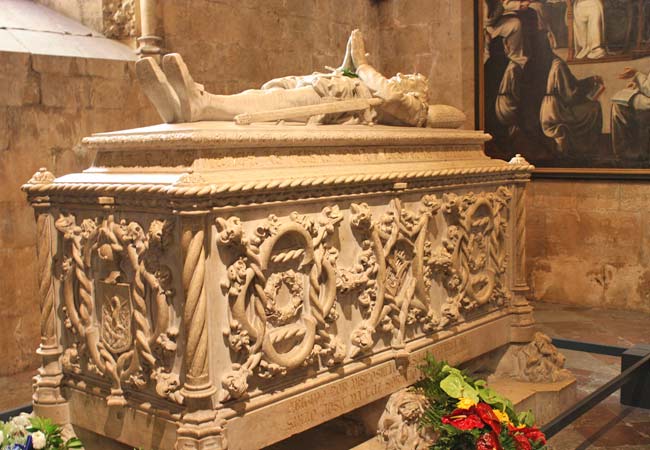
The tomb of Luis Camões, who in 1572 wrote the 'The Lusiads', which is regarded as the most important piece of Portuguese literature.
The Mosteiro dos Jeronimos is one of the most popular tourist attractions of Lisbon, and visitor numbers are limited for safety.
It is advisable to pre-purchase tickets, and these tickets will have a timeslot that can be chosen (depending on availability). The monastery is managed by Patrimonio Cultural, a Portuguese government agency, and tickets can be purchased from their website:
https://bilheteira.patrimoniocultural.pt/pos/event/list
(On their webpage, scroll down to the Monastery of Jerónimos link to purchase tickets)
Warning: These tickets are time-specific, so arriving at the wrong time could result in a refusal of entry.
Even with the timed tickets, there can be very long queues to enter. This is made all the worse as there is no shade, and you will be fully exposed to the intense summer sun – so always bring some water. Infuriately, large group tours are able to skip the queue, and this can make the wait even longer.
There are no tickets for the Igreja de Santa María. If you wish to visit, you simply have to join the queue and wait. This queue can be as long as the cloisters in the peak season, but tends to lessen after 4pm.
Insight: The queue for the cloisters is on the left side, and the queue for the Igreja de Santa María is to the right.
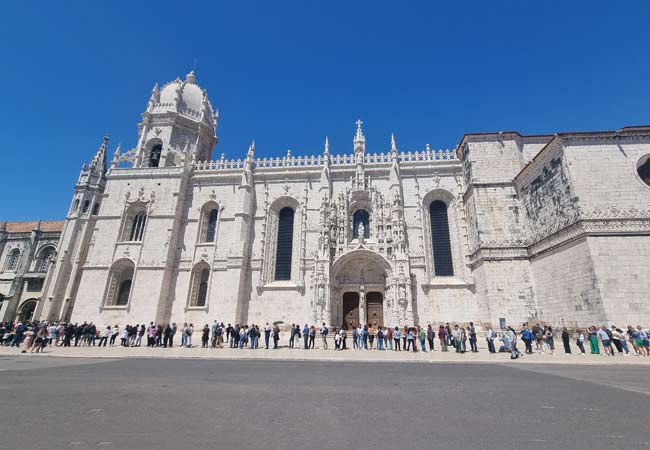
There are always long queues to enter; this is the queue for the church on a quiet Wednesday in April
The Monastery of Jerónimos offers free entry with the Lisbon Card (€22 for 24 hours), but bear in mind that you may still need to queue at the entrance. The Lisbon Card provides excellent value for a day trip to Belem if you're planning to visit the Museu Nacional dos Coches, the Torre de Belém and the Monastery of Jerónimos, as it also includes unlimited use of public transport.
Interesting facts about the Mosteiro dos Jerónimos
During the 15th century, the Belem district was a small town known as Restelo, home to Lisbon's shipyards and docks. In this era, the Tejo estuary was much wider, with a beach extending up to where the Mosteiro dos Jerónimos stands today.
Originally, a small hermitage and chapel stood where the Monastery of Jerónimos is now. It was a tradition, borne out of the sailors' deep-seated superstitions, to spend a night in vigil there before embarking on their voyages. This included Vasco da Gama in 1496, before his voyage to India.
The original plan for the monastery was for a complex which could house 100 monks, and its construction began in 1502. In 1518, King Manuel I significantly altered the purpose of the church, envisioning it as the royal pantheon of the Avis dynasty. The king died in 1521, and his tomb lies within the church, near that of his second wife, Maria of Aragon.
The Hieronymites order of monks who resided in the Mosteiro dos Jerónimos were dedicated to Saint Jerome, a 5th-century scholar most famed for the translation of the Bible into Latin. King Manuel chose this relatively obscure order to be based in the monastery because they offered spiritual protection to him and his descendants through their daily prayers.
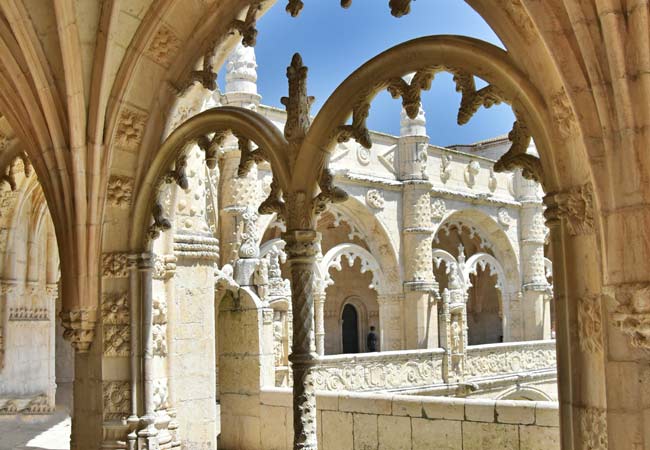
The intricate, fine carving of the upper cloister
Image tour of the Mosteiro dos Jerónimos
The cloisters can only be visited via the admission fee. This paid section begins with the upper cloister and the high choir, then visits the lower level where the Chapter House and refectory can be seen. The following image tour shows all of these sections.
Insight: There are very few information panels within the cloisters, and it is very easy to wander through and miss many of the details.
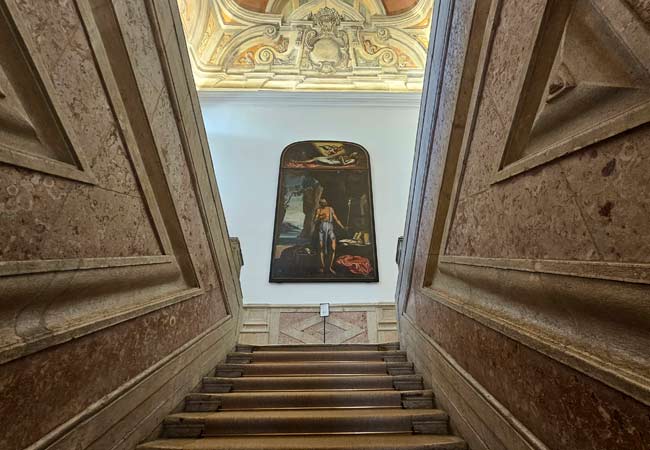
The ticket hall leads to a grand flight of stairs, which passes a 17th-century painting of Saint Jerome while he was a hermit in the Syrian desert.
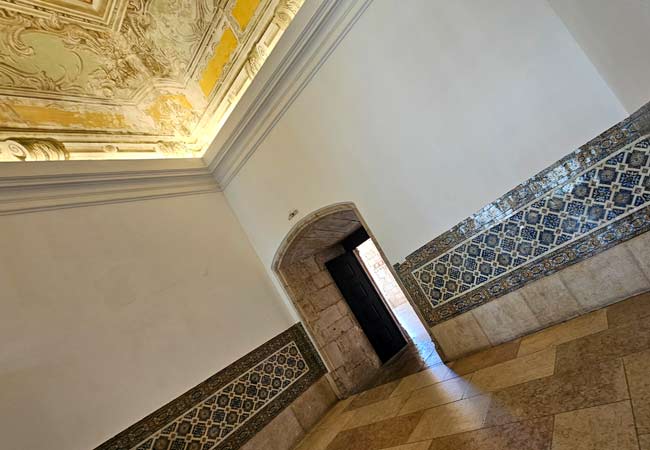
The next room has very little importance today, as it was the gift shop in a previous layout of the monastery. It was originally part of the corridor connecting the dormitories in the west wing to the cloisters.
The west wing is not seen in the tour of the cloisters, but the sheer size and number of the former dormitories can be appreciated when viewed from the outside.
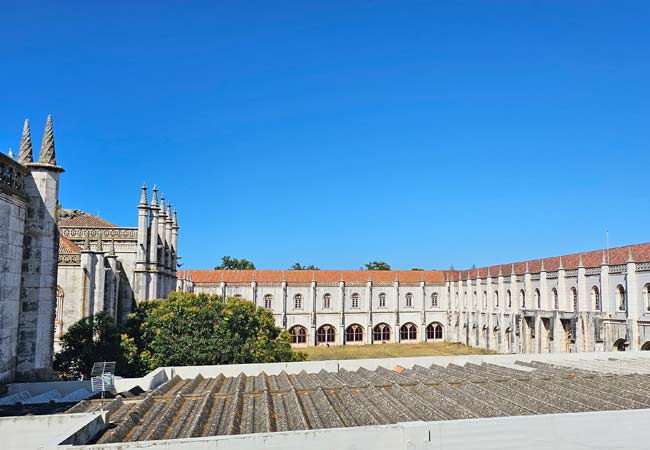
The tour enters the cloister from the southwestern side of the upper level.
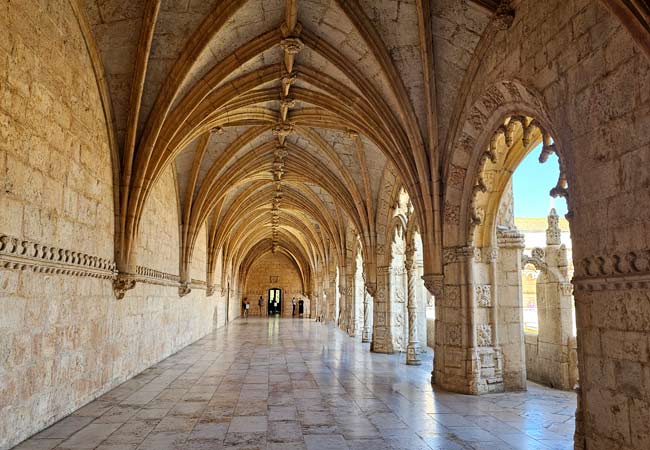
This area is always popular for photos, but the more detailed carvings are on the lower level.
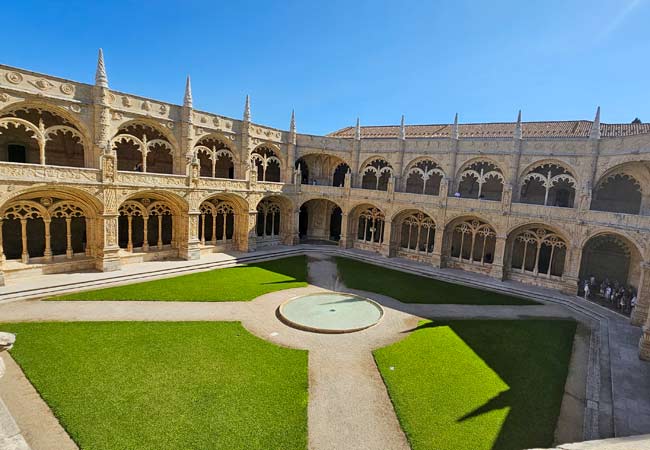
The cloister is one of the largest in Portugal, and the central courtyard is 55 meters wide.
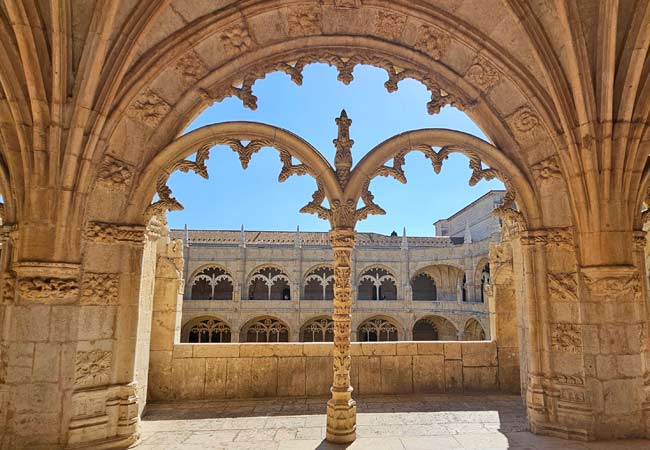
The ornate arches are surrounded by a mix of religious icons, maritime symbols and royal imagery. The whole complex was constructed as a statement of Portugal's power and dominance, along with being envisaged by King Manuel as the royal pantheon for him and his descendants.
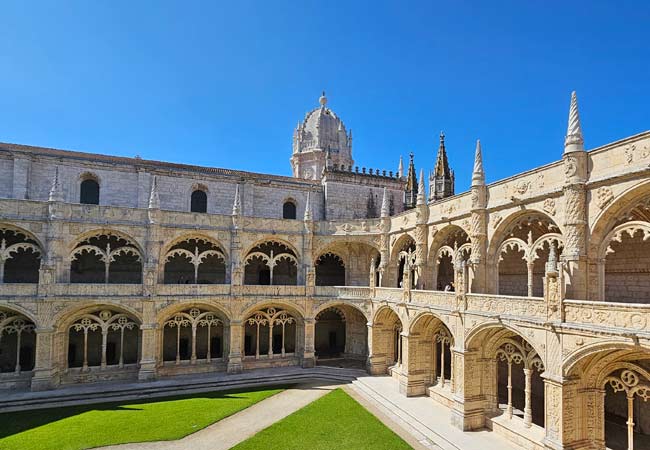
Looking southwards over the cloister to the Igreja de Santa María and its domed tower.
The golden colour of the cloister is from the 'Lioz' limestone that was mined in Ajuda, just to the north of Belem.
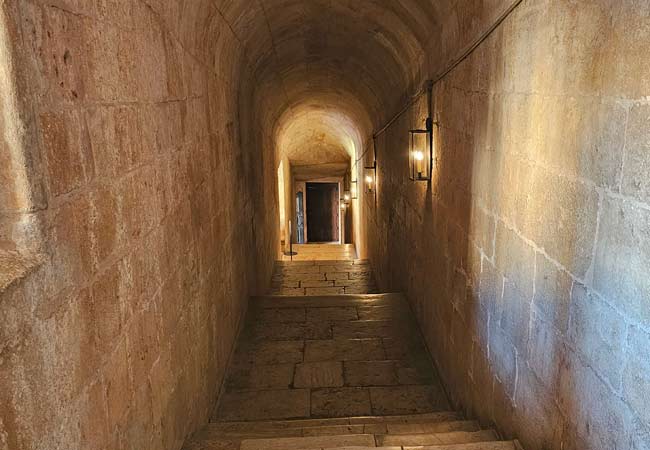
After appreciating the upper level, you will descend these simplistic stairs to the lower level.

The lower cloister has much more extravagant carvings and details, with almost every surface containing an ornamental feature. There are numerous features, including carved vines, knots and leaves on the twisting columns.
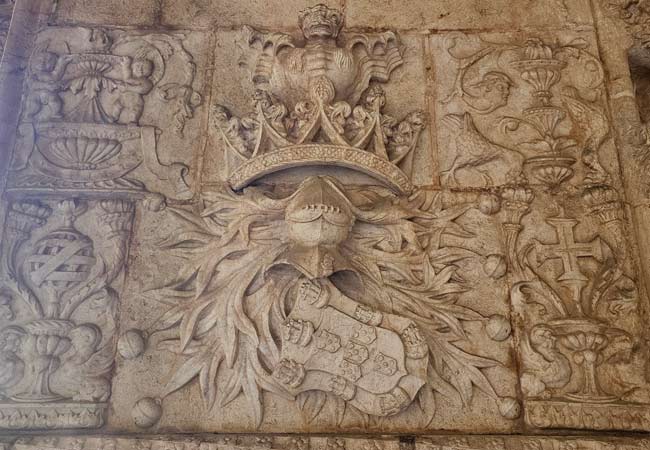
At the base of the stairs is a very interesting stone carving, as it is the only one to show the Portuguese shield at a lopsided angle. This was intentional, as it represents the shield being carried by King Manuel while mounted on a horse, and his helmet can be seen above it.
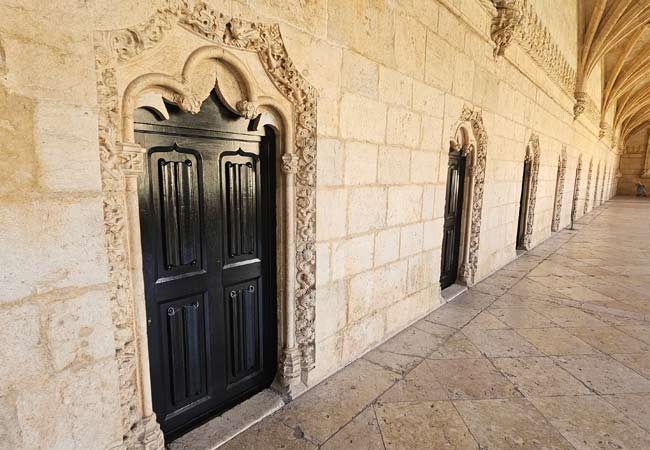
On the southern side are the 10 confessionals, where monks would listen to the confessions of the congregation (who were often sailors). The monks would enter from the cloister, and the repenter would enter from the church, with a thick metal grill separating them. There were originally 12, but two were removed with the addition of an altar in the church.
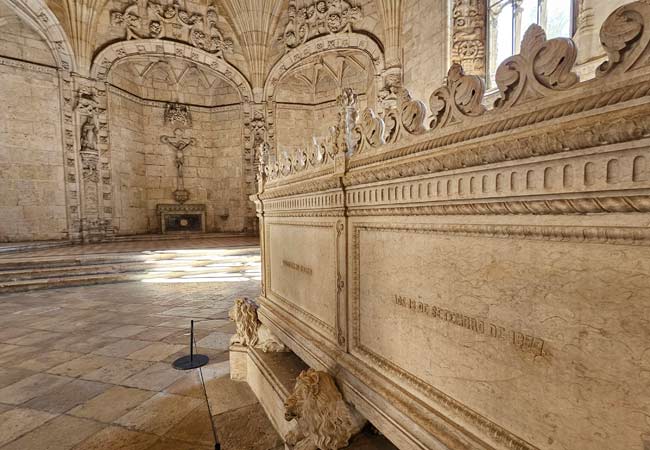
The Chapter House contains the Tomb of Alexandre Herculano. This tomb, when created in 1887, was much more intricate, but the styling was toned down in 1940 so that it was no more grand than the tombs of Vasco da Gama or Luis de Camoes, both located in the church.
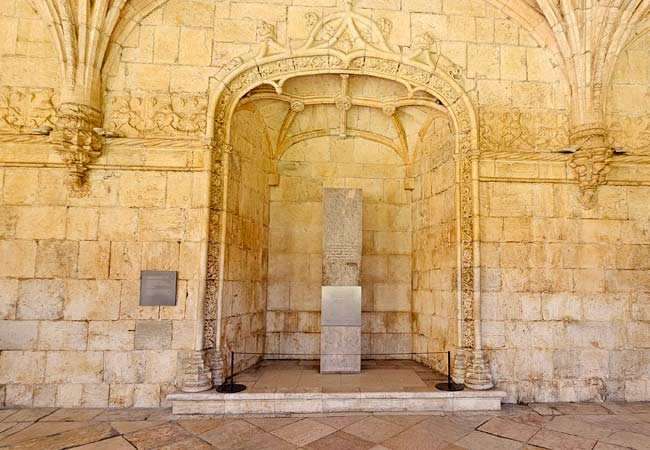
Standing in stark contrast to all of the elaborate carvings is the tomb of Fernando Pessoa, Portugal's most famous poet, who died in 1935.
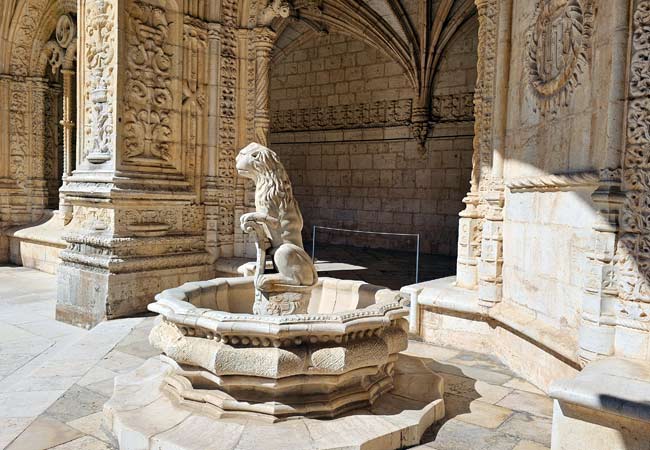
Outside of the refectory is a fountain, where monks would wash their hands before entering the building. The centrepiece statue of the fountain is a lion, the heraldic symbol of Saint Jerome, and one of the only symbols of the Hieronymites order who actually used the monastery.
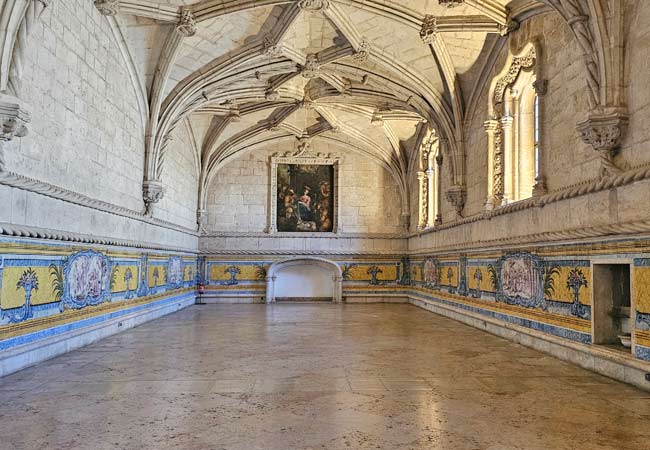
The refectory is much more simplistic in styling, with a low-vaulted and multi-ribbed ceiling. The refectory was constructed by the second architect of the monastery, João de Castilho, who led construction between 1517-1521 and is credited for much of the beautiful stonework.
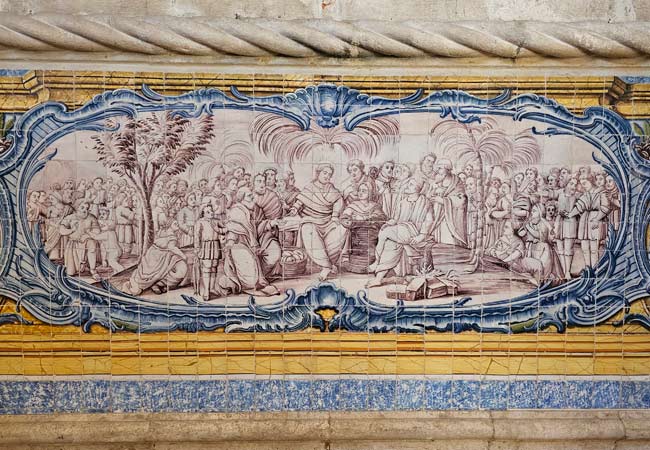
In 1781, the walls of the refectory were lined with tile paintings. The best painting is at the head of the room and depicts the feeding of the 5,000 from the bible.
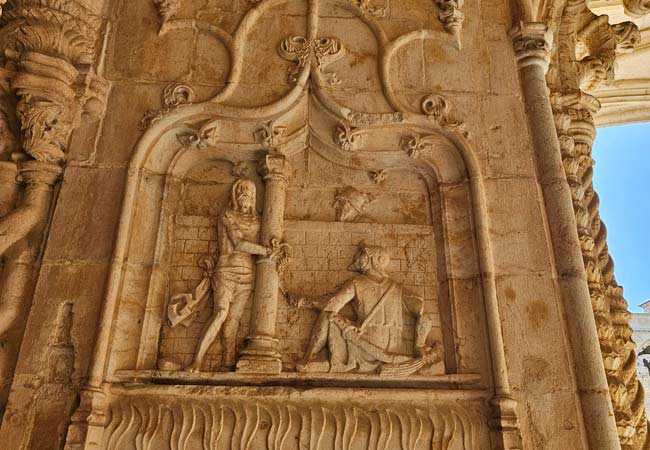
The eastern side of the cloister leads back to the ticket office and concludes all of the areas that can be seen in the paid section Mosteiro dos Jeronimos. Before leaving, do take a second wander of the lower level and appreciate the images that have been carved into the inside of the stone pillars. These are easy to miss on your first walk around.
History of the Monastery of Jerónimos
The Jerónimos monastery has had a varied history. Some key points from its past are:
• 1452: Infante Dom Henrique order the construction of the Hermitage of Santa María de Belém
• July 1497: Vasco da Gama spent his last night in vigil in the Santa María Hermitage
• 1496: Manuel I requests papal permission to construct a monastery on the site.
• 1501: Construction of the monastery and church begins, financed by the Vintena da Pimienta, a 5% tax on trade with Africa and the East.
• 1514-1516: Architect Diogo de Boitaca oversees construction, designing in an emerging Manueline style.
• 1517: João de Castilho takes over from Boitaca, introducing Plateresque and Renaissance structures, building the church, cloister, and sacristy.
• 1521: Construction halted upon King Manuel's death, later resumed under King John III.
• 1544: Diogo de Torralva becomes head architect, adding the main chapel, choir, and completing the two monastery floors.
• 1604: Philip II of Spain transforms the monastery into a royal mausoleum, allowing only the royal family and Jerónimos monks access.
• 1640: Bento de Siqueira commissions the monastery library, depositing collections from the religious order and Infante Luis, son of King Manuel I.
• 1755: The monastery miraculously survives the Lisbon earthquake, sustaining minor damage to the balustrade and upper choir.
• 1833: The monastery is secularised by state decree, and ownership is transferred to the Real Casa Pía de Lisbon, becoming a parish church.
• 1860: Restoration work begins, starting with the southern facade under architect Rafael Silva e Castro, continuing later under Domingos Parente da Silva.
• 1898: Vasco da Gama's tomb was restored in time for the 400th anniversary of his arrival in India, the same year the mausoleums for Gama and Luís de Camões were constructed.
• 1939: Extensive restoration projects are completed as part of the celebrations for the centenary of modern Portugal.
Discover more of Lisbon with our most popular guides
If you've found our content valuable, we'd welcome your support.
The digital publishing landscape has evolved significantly. As a small independent publisher, we face growing challenges. Search engines increasingly favour paid content over organic results, while AI-generated content often reproduces original work without attribution.
To support our work, please consider bookmarking this page (press Ctrl + D) for quick access. If you find an article helpful, we'd be grateful if you'd share it with friends on social media.
For specific questions, please see our Reddit community at r/LisbonPortugalTravel.
Should you notice any outdated or incorrect information, please contact us at [email protected]
Thank you for helping us continue to provide valuable content in an increasingly challenging digital environment.
A complete list of all of our Lisbon articles
If you've found our content valuable, we'd welcome your support.
The digital publishing landscape has evolved significantly. As a small independent publisher, we face growing challenges. Search engines increasingly favour paid content over organic results, while AI-generated content often reproduces original work without attribution.
To support our work, please consider bookmarking this page (press Ctrl + D) for quick access. If you find an article helpful, we'd be grateful if you'd share it with friends on social media.
For specific questions, please see our Reddit community at r/LisbonPortugalTravel.
Should you notice any outdated or incorrect information, please contact us at [email protected]
Thank you for helping us continue to provide valuable content in an increasingly challenging digital environment.



































